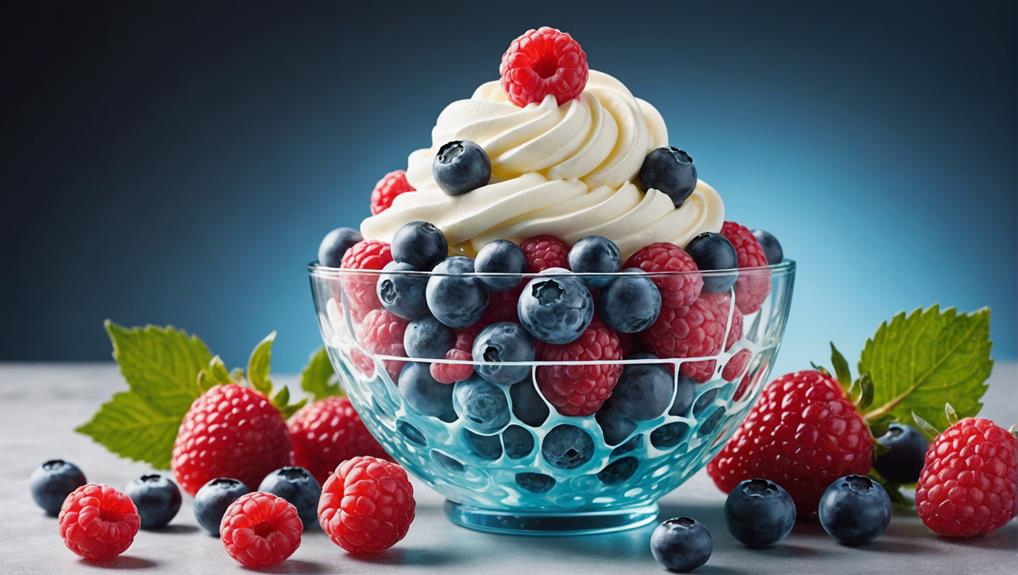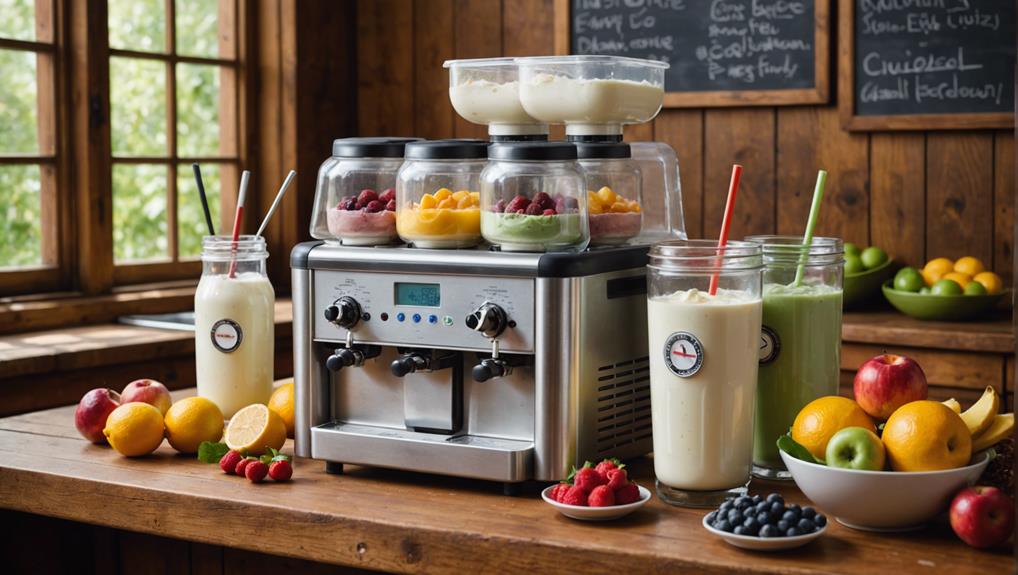Biotechnology in frozen yogurt primarily involves microencapsulation techniques that enhance product functionality. Microencapsulation stabilizes bioactive ingredients such as omega-3, probiotics, and antioxidants, improving shelf life and nutritional benefits. This method preserves the sensory properties by masking undesirable flavors while ensuring a consistent texture and controlled release of active compounds. It also reduces melting rates, consequently maintaining product quality. Incorporating these technological advancements meets the consumer demand for functional foods. Explore further to understand how these innovations are shaping the future of frozen yogurt.
Key Takeaways
- Microencapsulation stabilizes bioactive ingredients, ensuring consistent texture and extended shelf life in frozen yogurt.
- Encapsulation techniques mask undesirable flavors, enhancing the sensory experience without compromising product quality.
- Probiotic cultures and bioactive ingredients deliver health benefits like improved gut health and immune support.
- Controlled release of active ingredients preserves taste and odor profiles, enhancing consumer satisfaction.
- Biotechnology fuses with food science to incorporate essential nutrients, aligning with consumer demand for functional foods.
Microencapsulation Techniques

Microencapsulation techniques, such as phase separation by coacervation, play a critical role in the food industry by controlling the release of active ingredients and enhancing the sensory properties of frozen yogurt. Microencapsulation involves enclosing active encapsulated ingredients within a protective barrier, which greatly improves product functionality. Specifically, in frozen yogurt development, this technology stabilizes ingredients, thereby reducing melting rates and ensuring a consistent texture.
Phase separation by coacervation is a particularly effective method, as it does not require organic solvents, making it suitable for food applications. This process involves the formation of microspheres that encapsulate sensitive components, protecting them from environmental factors such as oxidation and moisture, which in turn extends the shelf life of the product. By masking unwanted flavors, colors, and smells, microencapsulation enhances the sensory properties of frozen yogurt, making it more appealing to consumers.
Furthermore, the controlled release of these active encapsulated ingredients ensures that the sensory and nutritional benefits are delivered effectively throughout the product’s consumption. Overall, microencapsulation through phase separation by coacervation not only maintains the quality of frozen yogurt but also enhances its marketability by improving both product performance and consumer satisfaction.
Bioactive Ingredients
Incorporating bioactive ingredients into frozen yogurt through advanced microencapsulation techniques greatly enhances the product’s functional and nutritional profile. Key bioactive ingredients such as microencapsulated ascorbic acid and omega 3 are introduced to fortify the product with essential nutrients, enhancing its functional properties. Encapsulation technology, specifically using microspheres, effectively masks unwanted tastes and odors, preventing flavor alterations that could deter consumer acceptance.
| Bioactive Ingredient | Functional Property |
|---|---|
| Ascorbic Acid | Antioxidant |
| Omega 3 | Anti-inflammatory |
| Probiotics | Gut Health |
| Polyphenols | Antioxidant |
| Peptides | Muscle Recovery |
Moreover, these microspheres serve as robust delivery systems, ensuring the bioactive components remain stable during storage and throughout the product’s shelf life. By safeguarding these sensitive ingredients from degradation, the encapsulation technology maintains that the frozen yogurt retains its sensory properties and overall quality.
The integration of microencapsulated bioactive ingredients not only enhances the nutritional profile but also adds significant value by improving the stability and health benefits of the frozen yogurt. Consequently, this biotechnological advancement presents a promising approach to developing functional frozen yogurt products that meet consumer demands for health and wellness.
Nutritional Enhancements

Enhancing the nutritional profile of frozen yogurt involves the strategic addition of probiotic cultures and microencapsulated bioactive ingredients, such as omega-3 fatty acids and ascorbic acid, which have been shown to provide significant health benefits without compromising the product’s sensory quality. Incorporating these nutritional enhancements into dairy-based and fermented food products like frozen yogurt not only boosts their health benefits but also aligns with modern consumer demands for functional foods.
Probiotic cultures play a pivotal role in improving gut health, as they introduce beneficial bacteria that aid in digestion and enhance the immune system. The use of microencapsulated bioactive ingredients ensures stability and effectiveness, as microspheres protect sensitive compounds from degradation and mask undesirable tastes and odors. This innovative approach leverages biotechnology to maintain the sensory appeal of frozen yogurt, as confirmed through rigorous sensory analysis.
- Probiotic cultures: Enhance gut health and support the immune system.
- Microencapsulated bioactive ingredients: Protect sensitive nutrients and improve shelf life.
- Microspheres: Aid in masking undesirable flavors and odors while delivering essential nutrients.
This fusion of biotechnology and food science paves the way for frozen yogurt to be a nutrient-dense, appealing option in the functional food market.
Sensory Improvements
Utilizing advanced biotechnological methods, the sensory properties of frozen yogurt can be greatly enhanced by employing encapsulated microspheres to mask the taste and odor of active ingredients, ensuring a more pleasant consumer experience. Microencapsulation techniques have been shown to effectively conceal undesirable sensory characteristics without compromising the overall quality of the product. Encapsulated microspheres, for instance, can envelop active ingredients like ascorbic acid, thereby preventing their potent taste and odor from affecting the frozen yogurt’s flavor profile.
These microspheres not only improve the sensory properties but also act as stabilizers, reducing the melting rate and enhancing the textural attributes of frozen yogurt. This dual functionality is essential for maintaining the integrity and sensory appeal of functional frozen yogurt products. In addition, microencapsulation contributes to the overall sensory improvements by ensuring that the active ingredients are released in a controlled manner, preserving the intended taste and odor profile of the final product.
Shelf Life Extension

By employing microencapsulation techniques, the shelf life of bioactive ingredients in frozen yogurt can be greatly extended, providing protection against degradation in acidic environments and ensuring prolonged functionality. This advanced encapsulation technology is especially effective for sensitive compounds such as ascorbic acid and omega 3 fatty acids, which are prone to rapid degradation.
Microencapsulation involves encapsulating bioactive ingredients within microspheres, acting as a stabilizer that not only preserves their activity but also reduces the melting rate of frozen yogurt. This preservation method extends the viability of these components for up to six weeks. Moreover, the swelling properties of these microspheres facilitate the incorporation of omega 3 without compromising the texture of the frozen yogurt, an important factor for maintaining consumer acceptance.
Key benefits of microencapsulation in frozen yogurt include:
- Protection of bioactive ingredients like ascorbic acid and omega 3 from acidic degradation
- Enhanced stability and reduction in melting rate, improving product quality
- Sensory analysis confirms no alteration in taste, odor, or overall quality, ensuring high consumer acceptance
These findings are corroborated by extensive sensory analysis, which reveals that microencapsulation does not negatively impact the sensory attributes of frozen yogurt, thereby maintaining the product’s appeal to consumers.
Frequently Asked Questions
How Is Yogurt Produced Through Biotechnology?
Yogurt production through biotechnology involves strain selection, genetic modification, and enzyme reactions during the fermentation process. Key aspects include optimizing bacterial growth, lactose metabolism, and culture conditions, alongside bioreactor design for flavor enhancement and textural improvement.
Are Cultures Still Alive in Frozen Yogurt?
How does the fermentation process impact live bacteria in frozen yogurt? Despite freezing impact, adequate yogurt storage safeguards culture preservation and maintains microbial activity of beneficial bacterial strains, thereby retaining health benefits even in dairy alternatives.
What Are Bio Cultures in Yogurt?
Bio cultures in yogurt consist of live bacteria and microbial strains initiated by starter cultures during the fermentation process, enhancing gut health, lactose digestion, and other health benefits across various yogurt varieties through effective dairy fermentation and bacterial cultures.
Do Probiotics Survive in Frozen Yogurt?
Probiotic viability in frozen yogurt depends on bacterial strains, freezing temperatures, and storage conditions. Successful fermentation processes and formulation techniques guarantee probiotic survival, preserving health claims, digestive benefits, yogurt texture, dietary impact, and shelf life integrity.
Conclusion
The integration of biotechnology in frozen yogurt production has demonstrated significant advancements through microencapsulation techniques, incorporation of bioactive ingredients, nutritional enhancements, sensory improvements, and shelf life extension. These innovations, supported by empirical studies, have not only improved consumer satisfaction but also contributed to health benefits. The theory that biotechnology can revolutionize food products is substantiated by the measurable improvements in frozen yogurt, indicating a promising future for its broader application in the food industry.







